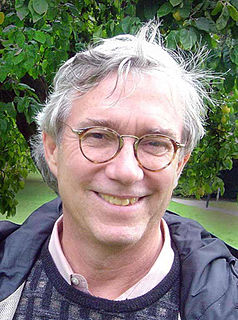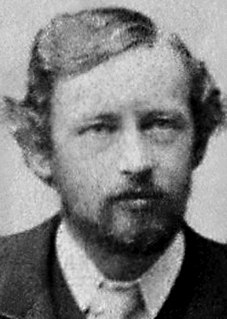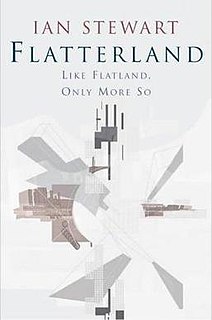
In physics and mathematics, the dimension of a mathematical space is informally defined as the minimum number of coordinates needed to specify any point within it. Thus a line has a dimension of one (1D) because only one coordinate is needed to specify a point on it – for example, the point at 5 on a number line. A surface such as a plane or the surface of a cylinder or sphere has a dimension of two (2D) because two coordinates are needed to specify a point on it – for example, both a latitude and longitude are required to locate a point on the surface of a sphere. The inside of a cube, a cylinder or a sphere is three-dimensional (3D) because three coordinates are needed to locate a point within these spaces.

In geometry, the tesseract is the four-dimensional analogue of the cube; the tesseract is to the cube as the cube is to the square. Just as the surface of the cube consists of six square faces, the hypersurface of the tesseract consists of eight cubical cells. The tesseract is one of the six convex regular 4-polytopes.

Flatland: A Romance of Many Dimensions is a satirical novella by the English schoolmaster Edwin Abbott Abbott, first published in 1884 by Seeley & Co. of London. Written pseudonymously by "A Square", the book used the fictional two-dimensional world of Flatland to comment on the hierarchy of Victorian culture, but the novella's more enduring contribution is its examination of dimensions.

Rudolf von Bitter Rucker is an American mathematician, computer scientist, science fiction author, and one of the founders of the cyberpunk literary movement. The author of both fiction and non-fiction, he is best known for the novels in the Ware Tetralogy, the first two of which both won Philip K. Dick Awards. Until its closure in 2014 he edited the science fiction webzine Flurb.

Charles Howard Hinton was a British mathematician and writer of science fiction works titled Scientific Romances. He was interested in higher dimensions, particularly the fourth dimension. He is known for coining the word "tesseract" and for his work on methods of visualising the geometry of higher dimensions.

Flatterland is a 2001 book written by mathematician and science popularizer Ian Stewart about non-Euclidean geometry. It was written as a sequel to Flatland, an 1884 novel that discussed different dimensions.
The Planiverse (ISBN 0-387-98916-1) is a novel by A. K. Dewdney, written in 1984.

Everything and More: A Compact History of Infinity is a book by American novelist and essayist David Foster Wallace that examines the history of infinity, focusing primarily on the work of Georg Cantor, the 19th-century German mathematician who created set theory. The book is part of the W. W. Norton "Great Discoveries" series.

A four-dimensional space or 4D space is a mathematical extension of the concept of three-dimensional or 3D space. Three-dimensional space is the simplest possible abstraction of the observation that one only needs three numbers, called dimensions, to describe the sizes or locations of objects in the everyday world. For example, the volume of a rectangular box is found by measuring its length, width, and height.

Sphereland: A Fantasy About Curved Spaces and an Expanding Universe is a 1965 translation of Bolland : een roman van gekromde ruimten en uitdijend heelal, a 1957 novel by Dionys Burger, and is a sequel to Flatland, a novel by "A Square". The novel expands upon the social and mathematical foundations on which Flatland is based. It is markedly different from the first novel in that it has a more prosaic ending and treatment of society.
Popular mathematics is mathematical presentation aimed at a general audience. Sometimes this is in the form of books which require no mathematical background and in other cases it is in the form of expository articles written by professional mathematicians to reach out to others working in different areas.

Spaceland is a science fiction novel by American mathematician and computer scientist Rudy Rucker, and published in 2002 by Tor Books.

Flatland is a 2007 computer-animated film based on the 1884 novella Flatland: A Romance of Many Dimensions by Edwin Abbott Abbott. The film was directed and animated by Ladd Ehlinger Jr. in Lightwave 3D. The screenplay was written by author Tom Whalen. The music was composed by Mark Slater.
Dionys Burger was a Dutch secondary school physics teacher and author of the novel Sphereland.

A New Era of Thought is a non-fiction work written by Charles Howard Hinton, published in 1888 and reprinted in 1900 by Swan Sonnenschein & Co. Ltd., London. A New Era of Thought is about the fourth dimension and its implications on human thinking. It influenced the work of P.D. Ouspensky, particularly his book Tertium Organum where it is frequently quoted; Scientific American writer Martin Gardner, who mentioned this book in some of his articles; and Rudy Rucker's The Fourth Dimension. It is prefaced by Alicia Boole and H. John Falk. A New Era of Thought is inspired by Plato's allegory of the cave and is influenced by the works of Immanuel Kant, Carl Friedrich Gauss and Nikolai Lobachevsky. The book has xvi and 230 pages.

Flatland: The Movie is a short animated film which was released to video in 2007. The cast includes the voices of actors Martin Sheen, Kristen Bell and Tony Hale. The story is based on the 1884 science fiction novella Flatland: A Romance of Many Dimensions written by Edwin A. Abbott.

Infinity and the Mind: The Science and Philosophy of the Infinite is a popular mathematics book by American mathematician, computer scientist, and science fiction writer Rudy Rucker.
The idea of a fourth dimension has been a factor in the evolution of modern art, but use of concepts relating to higher dimensions has been little discussed by academics in the literary world. From the late 1800s onwards, many writers began to make use of possibilities opened up by the exploration of such concepts as hypercubes and non-Euclidean geometry. While many writers took the fourth dimension to be one of time, others preferred to think of it in spatial terms, and some associated the new mathematics with wider changes in modern culture.

Hiding in the Mirror is a popular science book by the theoretical physicist Lawrence M. Krauss. The text was initially published on October 20, 2005 by Viking Press. This is his seventh non-fiction book.
Algebra and Tiling: Homomorphisms in the Service of Geometry is a mathematics textbook on the use of group theory to answer questions about tessellations and higher dimensional honeycombs, partitions of the Euclidean plane or higher-dimensional spaces into congruent tiles. It was written by Sherman K. Stein and Sándor Szabó, and published by the Mathematical Association of America as volume 25 of their Carus Mathematical Monographs series in 1994. It won the 1998 Beckenbach Book Prize, and was reprinted in paperback in 2008.















